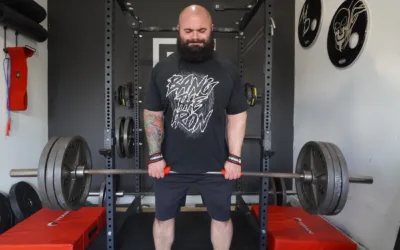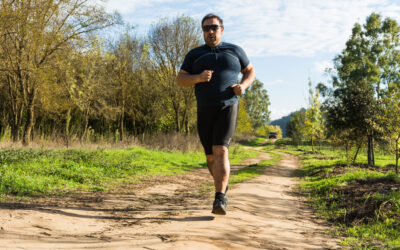Using the Right System for Your Metabolic Conditioning Work
TOPIC: Strength & Conditioning
Training metabolic conditioning can be problematic even for experienced athletes. The main questions: what are you trying to become more conditioned for? Which energy system needs the most work? What even are the body’s energy systems??
With smart work and effort, you can make massive gains in your fitness by training your power and capacity. This article will help you work backwards to figure that out. Plus, check out the sample workouts that test your conditioning in different ways.

Written By
jack mccormick
Jack has been a strength and conditioning coach and trainer since 2009. He’s worked in a range of settings from college sports performance to tactical S&C.
It’s Time to Fix Your Metabolic Conditioning
“The best way to predict the future is to create it.”
I heard this quote during a presentation about programming and periodization. At that time in my career, I felt that programming could get overwhelming and I would spend hours at my computer trying to plan long-term programs only to hit delete and start over again. I was never sure whether the program I was writing would work.
But when we think about starting with the end goal in mind, the process by which we go about creating a roadmap to get there becomes much more clear. Understanding the different stops along the way and methods we can use to reach them makes creating the plan a much smoother experience.
My goal in this article is to help explain in broad strokes the different “steps” along the spectrum of conditioning and energy systems development. Whether you’re a competitive athlete preparing for the demands of a college sports season or you’re simply looking to get some guidance on your conditioning, you can have a basic outline of the energy systems journey. From there, you can create your own future with the end in mind.
I’ll give examples of some of my favorite ways to address each method, plus a few points to consider about whether you are just doing “cardio” or “conditioning.”
Energy Systems 101
Understanding the different systems our bodies use to perform work at various intensities and durations is important to grasp the general spectrum of energy production.
Our bodies use adenosine triphosphate (ATP) as the currency for muscle contractions. The body has three primary systems that will allow it to utilize ATP at rates that are either very fast when energy is needed quickly (for example, when performing a 10-second bike sprint), slowly when the need for energy is not as intense (such as when going for a long jog), and for moderate intensity when the need is in between the two.
These three systems are the alactic system, the lactic anaerobic system, and the aerobic system. While all three of these systems are actually at work during any type of physical activity, each one will have points at which it will be the preferred method of energy production. Think of these systems as having “dimmers” on them like a lightswitch in a room instead of having a complete on/off button. Each of these systems has its advantages and disadvantages for energy production.
Alactic
The alactic system is great for activities that are short and intense, less than about 12 seconds or so according to Joel Jamieson’s “Ultimate MMA Conditioning” (2009, p. 30), because this system can utilize ATP very quickly. However, its capacity is quite limited because it relies on stored ATP in our muscles that is ready to be deployed immediately. So while this system is capable of helping us perform powerful and intense work, it can only do so for a matter of seconds.
Anaerobic
When the demand for energy exceeds the duration available from the alactic system we can turn to the anaerobic lactic system for help. This system can generate ATP through a process called glycolysis in which stored sugars are broken down into ATP and additional compounds. While this system can produce ATP for a longer period of time (around one minute or so, give or take (Jamieson, 2009, p. 49), it won’t allow us to work as intensely as the alactic system does.
Aerobic
When the duration of activity lasts longer than a minute or so we can call on the aerobic system to become our primary source of ATP production and utilization. The aerobic system can break down stored fats to generate ATP and provide energy for hours, although the chemical processes required to complete this are longer and don’t allow for energy production as readily or with as much power output. The aerobic system is great for providing energy when the intensity or rate of work isn’t as high, but the duration, whether constantly or intermittently, is longer.

Power and Capacity
We can now break down each of the energy systems into their “power” and “capacity” components. The power of one of these energy systems can be thought of as how much work can be done in a specified amount of time. In order to properly train this, the intensity needs to be high and the recovery between repetitions needs to be full.
The capacity side of an energy system relates to how much you can do with that energy system over the entire duration it is dominant. To start things off with some examples, let’s think of the alactic system.
Training the Alactic System
Alactic power can be thought of as how much work can be done quickly in a very short amount of time. Pushing a sled for 3-6 seconds as hard and fast as you can to see how far you can go is one way of measuring this. The power of your alactic system can be thought of as measuring (force x distance)/time.
If you can push a sled with 90 lbs on it 7 yards in 7 seconds, but after several weeks of training, you manage to push a sled with 100 lbs on it for the same 7 yards in 7 seconds, you have increased the power of your alactic system.
Let’s take that original 90 lb sled for 7 yards in 7 seconds, then after that point you slow down. If after several weeks of training you are able to push that same sled for 8 yards in 8 seconds, then 10 yards in 10 seconds, and maybe even 12 yards in 12 seconds, you have enhanced the capacity of your alactic system. You’re able to sustain the same amount of power you had several weeks ago for a longer period of time while still being within that primarily alactic dominant time range.
Sample Programming
- Alactic power: Push a sled with a fixed weight as hard and fast as you can for 6-8 seconds and pay attention to your distance covered. Rest for 2 minutes before going again. Perform 5-6 reps. Over time, see if you can push the sled with the same weight farther, or add more weight and push it the same distance.
- Alactic capacity: Push a sled with a fixed weight as hard and fast as you can for 10-12 seconds and pay attention to your distance covered. Rest for 1-2 minutes before going again. Over time, see if you can enhance the time that you can push the sled at the same speed.
Once you can hit the above sample workout upper limits, you can start to challenge yourself more by reducing the rest interval during your capacity intervals (i.e. going from 2 minutes down to 1, or even 45 seconds). You can also see if you can do more reps at the same power output during your alactic power intervals.
Once your quality of work drops off, stop the exercise and note your progress. Trying to improve your repeatability of these efforts for either more reps or with shorter recovery over time is a great way to gauge progress in your conditioning.
Training The Anaerobic System
For lactic/anaerobic power and capacity, something like an airbike, versaclimber, or rower works great because the machine’s computer allows you to see exactly how much work was done, be it distance, calories, wattage, etc. Remember, the lactic system will be most dominant for around 20-60 seconds, so to focus on lactic power we should keep work times from about 20-40 seconds. To focus more on capacity, we can up the time range to about 40-60 seconds.
When I was a college strength coach, we used 150 and 300 yard shuttles to train the lactic system, with 150s focusing more on power and 300s targeting capacity. Again, the big key is utilizing appropriate rest-to-work ratios while hitting the duration range that targets the adaptation we want. For lactic power intervals, I would recommend resting at least 1 minute, up to 4 minutes if necessary. Remember, maximum output is necessary to train for power, so you must be fully recovered. Using a minimum of 3:1, up to 6:1 rest-to-work ratio is a good idea. For lactic capacity intervals, we can shorten the rest-to-work ratio to more like 2:1 or 3:1.
Sample Programming
- Lactic power: Ride an assault bike as hard as you can for 20 seconds, then perform an active rest of slow pedaling for 2 minutes. Notice how many calories you accrue or how much distance you travel (to the nearest hundredth of a mile if possible). Perform 3-4 sets of this to start out, trying to cover the same distance as your first.
- Lactic capacity: Cover as much distance on an assault bike as you can in 45 seconds, then actively rest with slow pedaling for 90 seconds. Like before, note your distance, calories, etc. Start with 2 reps if you have never done this before and see if you can work your way up to doing 3.
A method I learned from Joel Jamieson’s “Ultimate MMA Conditioning” that I really like is to do two sets of these protocols (either the power or capacity intervals) separated by about 8-15 minutes of rest for power sets, and 4-6 minutes for capacity sets (pp. 59-60). This is a great way to increase the amount of total work that is done as long as your output stays high.
Just like the alactic system, the big key is to monitor if you are able to do more reps at the same power output over time with a specified rest-to-work ratio, or cover more distance/calories on the machine. For capacity, see if you can maintain the same power output for a 30-second ride and make it last for 40 seconds, which would show an improvement in your ability to buffer lactate buildup. See if you can maintain performance by gradually shortening the rest to work ratio from 3:1 down to 2.5:1 or 2:1.
Training The Aerobic System
The system that has the largest capacity for both improvement and ability to provide energy/recovery is the aerobic system. I feel that about 12 years ago the aerobic system really got demonized when the popularity of Tabatas gained traction. It isn’t that I don’t like Tabatas or see value in them, I just feel like coaches decided that if Tabatas were great, then the opposite must be ineffective or bad. The reality is that having a strong aerobic capacity is vital for performance, recovery, and overall longevity.
I use the threshold of 60 beats per minute for a resting heart rate measured first thing in the morning after waking (no caffeine) as a good barometer for basic aerobic fitness. For someone with a higher resting HR than this, adding in some cardiac output work can help performance recovery through eccentric hypertrophy (growth) of the left ventricle of the heart. This allows your heart to fill with a greater amount of blood and to eject a greater volume with each contraction. Oxygen then gets to your tissues more efficiently to help performance in the moment and to help you recover more quickly when needed.
My favorite method for cardiac output work is to use any sort of activity that will allow you to work consistently for about 30 minutes at a heart rate of about 120-150 (zone 2). The specific numbers might vary, but when we start to get higher than about 150 or so we miss out on the heart filling completely with blood and stimulating the eccentric hypertrophy, because it’s actually beating too fast. For those who don’t want to run, choose activities that take stress off the joints and have low to zero ground reaction forces like biking, swimming, elliptical, etc.
My favorite type of conditioning is aerobic power. When I was a college strength athlete learning about the value of aerobic power was an absolute game-changer for me. The aerobic system has the greatest capacity for energy production, so we want to work as hard as possible while still using the aerobic system. In effect, what is the highest rate of work we can do while still primarily using the aerobic system?
Enter Dan Baker’s “maximum aerobic speed” training (Baker, 2011). If you would like the full story of this concept I encourage you to look into his work. The simplest way to determine your maximum aerobic speed is to perform a time trial of any sort of activity for a period of about 5-8 minutes. My favorite method is a 3-mile airbike ride for time or a 1-mile run. If you do the bike, it’s imperative that you pay attention to the average RPMs/cadence that gets displayed at the end of the test. Or if you’re someone who prefers to track speed, you can record the average mph. As long as the test is done at a fairly consistent pace (i.e. you didn’t start out too fast and then gas out early) you’ll be provided with the speed at which you are able to maintain while primarily producing work from the aerobic system.
Then, we can program intervals based on this metric just as you can program weights in strength training off of a 1RM. My favorite method is to take a max aerobic speed and multiply it by 1.2, which would be 120% of that speed. Perform intervals of 15 seconds on, 15 seconds off while trying to hit that target speed/cadence.
For example, if your average RPMs during the bike test was 63, then 63 x 1.2 would be 75. So try to ride at a cadence of 75 for 15 seconds, then rest for 15, and repeat for 8 reps (so total time elapsed is just under 4 minutes). Rest for 2:30, then repeat for another set of 8.
The biggest challenge with this method is an athlete going out too hard/too fast, because that pace will actually feel easy in the beginning. By set 3, 4, or 5, it will start to feel just intense enough that you’re uncomfortable, but you can still hit the cadence for the time indicated. Those 15 seconds of rest start to feel awfully short by the end, but you still feel like you can go again.
I’ve had coaches and athletes think this was perhaps a waste of time after seeing the first couple of rounds, but athletes would routinely be quite tired, sweating, and glad it was over by the end of that second set and their heart rates were over 90%.
Sample Programming
120% of your max aerobic speed for 15 seconds on, 15 seconds off for 2 rounds of 8 separated by 2:30 rest in between sets.
Final Thoughts
The conditioning conundrum can be overwhelming. The most important thing to do in order to create that roadmap to success is to properly identify what it is you’re trying to become more conditioned for. Identify the demands of the activity you’re looking to be more conditioned for and work backwards from there. Is it running based? Is it continuous or intermittent? If intermittent, what is the average work duration, and what is the average recovery interval? How long does it last?
There is value in using each of the qualities in your overall conditioning at different points in time due to the physiological adaptations they all offer. Ultimately, identifying the demands of your desired activity and working backwards to hone in on the energy system that most closely resembles it should lead you in the right direction.
References
Baker, D. Recent trends in high-intensity aerobic training for field sports. UK Strength and Conditioning Association, 22, (p. 3-8).
Jamieson, Joel. Ultimate MMA Conditioning. Performance Sports Inc., 2009.
Find Your Perfect Training Plan
Sometimes all you need to reach your destination on your fitness journey is an expert guide. Look no further, we've got you covered. Browse from thousands of programs for any goal and every type of athlete.
Try any programming subscription FREE for 7 days!
Related Articles
You May Also Like...
Winter Warfare: How to Bulk Up This Season
It’s that time of the year to wreak havoc and prepare for a massive winter bulk! But wait, what is a winter bulk? What does it take, and how do we achieve it? Joseph Lucero (CSCS), owner of Harvesting Strength, is a powerlifter and strongman coach with years of...
How to Do Preacher Curls for Bigger Biceps
Who doesn’t love hitting a good biceps workout and feeling that skin-splitting pump? The preacher curl is a great exercise for bulking up your biceps, but using the EZ bar isn’t the best option for everyone. To build juicy biceps without pissing off your elbow joint,...
Breaking Through the Plateau: Taking Your Weight Loss Journey to the Next Level
You’ve shown up day after day, sweated through workouts, and resisted more cravings than you can count. But the numbers have ground to a stable halt.Hitting a plateau isn’t a failure, it’s proof you’ve been consistent and made real progress. Think of a plateau as your...
Winter Warfare: How to Bulk Up This Season
It’s that time of the year to wreak havoc and prepare for a massive winter bulk! But wait, what is a winter bulk? What does it take, and how do we achieve it? Joseph Lucero (CSCS), owner of Harvesting Strength, is a powerlifter and strongman coach with years of...
How to Do Preacher Curls for Bigger Biceps
Who doesn’t love hitting a good biceps workout and feeling that skin-splitting pump? The preacher curl is a great exercise for bulking up your biceps, but using the EZ bar isn’t the best option for everyone. To build juicy biceps without pissing off your elbow joint,...

Want more training content?
Subscribe
For Coaches
For Athletes
About
Support
Training Lab
Access the latest articles, reviews, and case studies from the top strength and conditioning minds in the TH Training Lab!
Made with love, sweat, protein isolate and hard work in Denver, CO
© 2024 TrainHeroic, Inc. All rights reserved.





